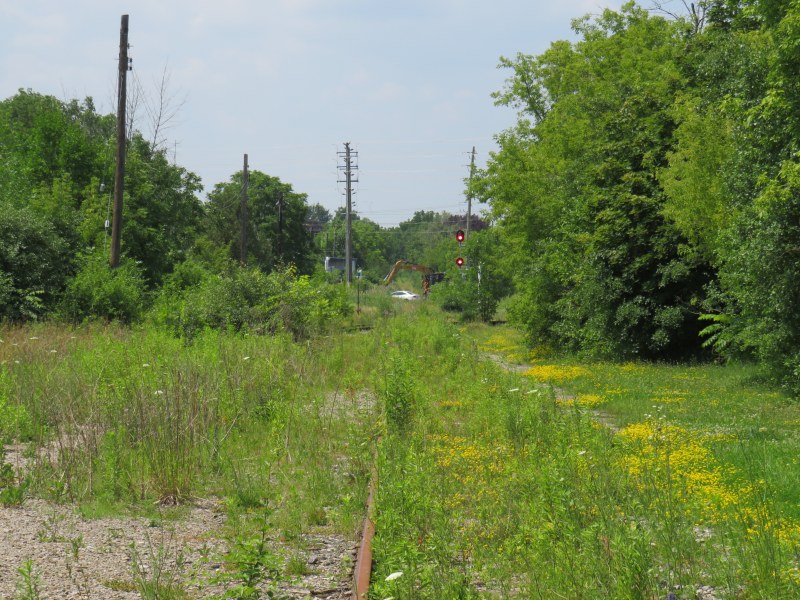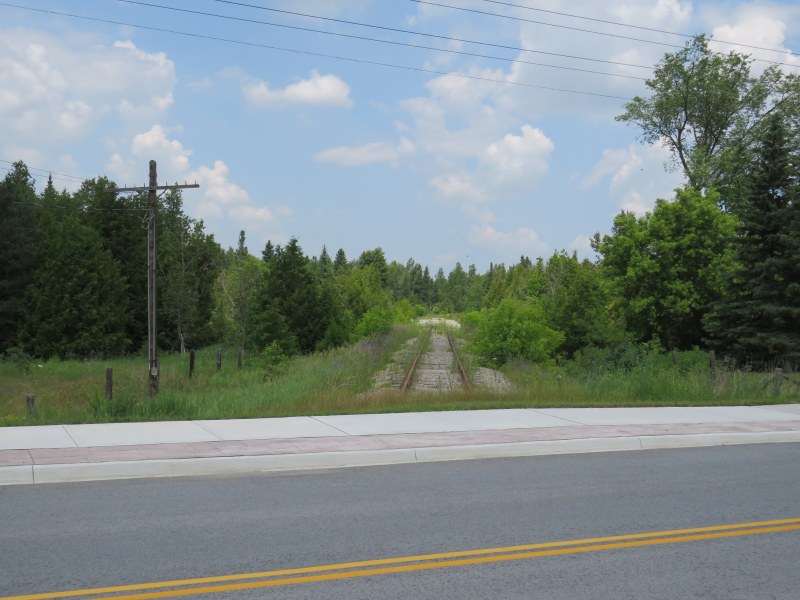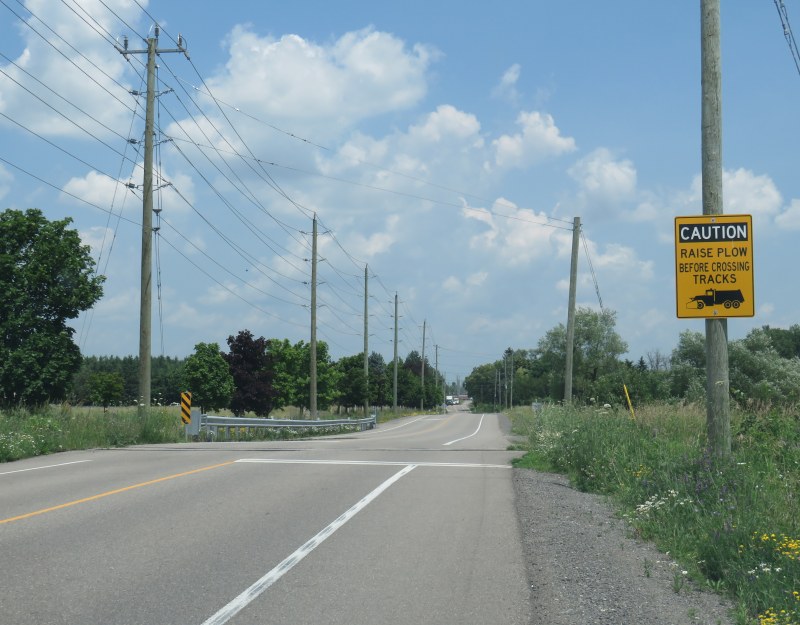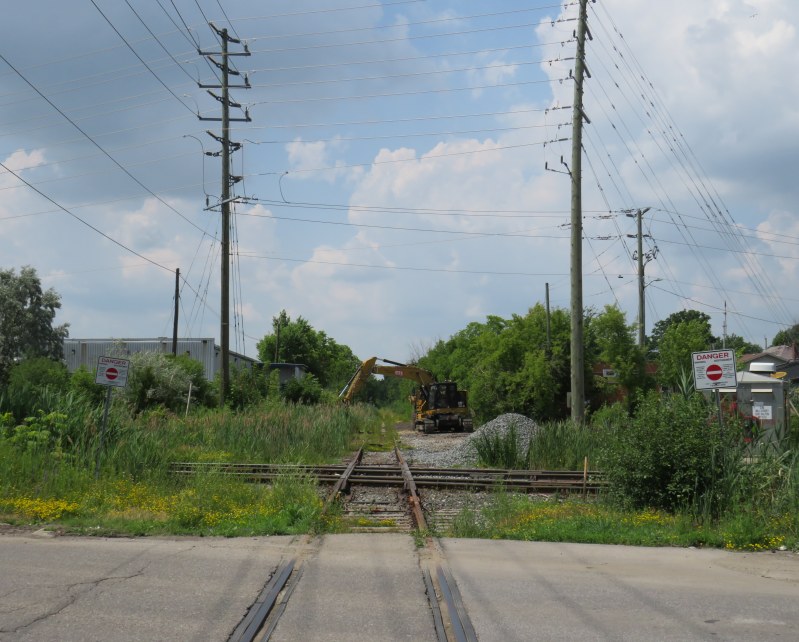
After the last train departed from Orangeville on December 17, 2021, the Orangeville-Brampton Railway (OBRY) became yet another abandoned railway, the last chapter of a once-expansive network of rails that branched out across Midwestern Ontario. Orangeville was the divisional point of Canadian Pacific’s Bruce lines, which served Owen Sound, Walkerton, Teeswater, Fergus and Elora, and dozens of towns and villages en route. By 1995, all of those branches were abandoned by CP, so in 2000, the Town of Orangeville purchased the remaining bit of track to serve local industries, and even launched a scenic excursion train, the Credit Valley Explorer, several years later. For about a decade, the future looked bright.
The Town of Orangeville, which was eager to walk away from the railway it once proudly owned, was quick to tear up the tracks within its boundaries, soon to be replaced by a new multi-use path. In July 2023, the ties are still mostly in place, for now, waiting to be dug up, and while the road crossings are now smooth, signal gantries are still standing on Broadway and Townline Road.
At the old yards and station grounds, the “new” station building, opened in 2007 for the Credit Valley Explorer and an office for OBRY rail crews, is being used as a temporary branch of the Orangeville Public Library, as the main Mill Street location undergoes major renovations.



Through Caledon and Brampton, however, the track remains mostly in place, though it has largely been covered by weeds. Near Alton, the Mile 31 signpost remains erect, though nature has completely taken over the right-of-way.
The Region of Peel now owns the corridor, with the promise of a new rail trail, though with the impending disbandment of that upper-tier municipality, it will be up to the Town of Caledon and the Cities of Brampton and Mississauga (and possibly Credit Valley Conservation) to follow through with removing the rails and ties and putting down a new trail.

In the meantime, the Region of Peel removed the crossings of Highway 136 near Alton. The rusted track simply disappears into the roadbed on either side. The crossing at Mayfield Road at the Brampton/Caledon border has also been removed to allow for widening of that major arterial road. Otherwise, the tracks are still in place, though weeds, debris, and concrete blocks placed at several bridges to deter unauthorized use, have made the rails impassable.


At several crossings, the crossbucks, lights and bells have been removed, replaced with warnings to plow drivers to raise their blades at the disused tracks.

In Brampton, though, transit buses still stop at the crossings on Queen Street, Bovaird Drive, and Steeles Avenue as if anytime was still train time. The signals protecting the diamond at the busy CN line in Downtown Brampton are still active, 18 months since the last train passed through on the Orangeville line.
When I last passed by the diamond, on July 5, I saw work equipment on the old OBRY right-of-way, so perhaps that, too, is not long for this world.


4 replies on “Lost in the weeds: OBRY, 18 months later”
This railway should be used as commuter railway, with railbuses. I am a neighbour, so saddened by this loss.
Thank you Sean for covering this topic.
It’s hard to believe it’s been a year and a half deactivated.
Unlike Max, I don’t see a business or even close to a practical operating case to made for commuter re-use.
For trail use? Absolutely. Every time I head out of town on the Kitchener GO rail line to cycle distance (and then take GO back into Toronto on another route after doing 50km+) I glance up the OBRY RoW and lament how if the trail was intact, without hesitation, I’d hop off at Guelph, take either the GOST (if I take the GO 29 bus from Kipling GO station at 9:00 AM) or cycle up to Elora to take the Cataract Trail across to connect to the OBRY Trail, and then reenter Toronto on a GO train from Brampton Station.
Or going out on GO train or bus to Georgetown, up to the Caledon Trailway and across to the OBRY Trail, or vice-versa.
As a multi-use trail, all sorts of possibilities open up. I’m still astounded as to how little the Province promotes the use of commuter rail/bus for cycling beyond the tired, overused and unexciting Niagara BikeTrain.
Rail with trail would allow the best of both worlds of having a rail line while also allowing people the opportunity for active transportation. Rail banking the line to keep it around while still building and allowing a trail has already been done by Simcoe County on the Meaford Trail and the BCRY route to Collingwood for over a decade as well as being done in many other places aside from Canada (i.e. it doesn’t have to just be rails or trails as both are beneficial yet necessary modal choices to support for curbing automobiles and road centric travel). The main reason trail potential already exists is because of other rail lines being subsequently abandoned and turned into trails which has come at the cost of most of Ontario’s branchline network in the Bruce.
Passenger use could make sense if done properly and not just a slave to the 9-5 Toronto grind as most of GO Transit and other similar rail services are (not to mention the line connects with the Milton Line already and the need for less road based transportion is increasing along with the Hurontario LRT still falling short of downtown Brampton with no definite date of it ever reaching there). Even connecting with other bus routes as an alternative to the heavily travelled Hurontario corridor on Brampton Transit would be useful given how valuable north-south travel routes are in Brampton and Peel as a whole (along with going over west from Hurontario).
Given how so much effort and money is poured into maintaining existing roadways and adding bus services but no such things can be allocated to railways in a meaningful way is part of why we’ve gotten into this scenario of continuting to lose functional rail lines even at a time when we know better but government refuses to enact support or protections for such or acknowledge their value as infrastructure assets and more people not demanding better of them (even the USA has more funding options and protections for rail than Canada which says something). It feels like people and politicians within the GTHA can only think of trains as viable if they’re GO Transit, an LRT, or a subway while Europe has figured out how to have different levels of service and suitable equipment because they support their networks and services
I agree Blane. Europe has figured out a varied public transport modes in so many places and on so many levels. Just go, take the most suitable example, and use it here.
However, my observation is, in the 70’s prevailing mentality was “rip everything old off”. Streetcar routes, narrow gauge railways and even some electric railways were destroyed. This treasure infrastructure was lost, I guess, forever.
Instead, spirit of conservation should prevail.
Today this mentality seems to be back.